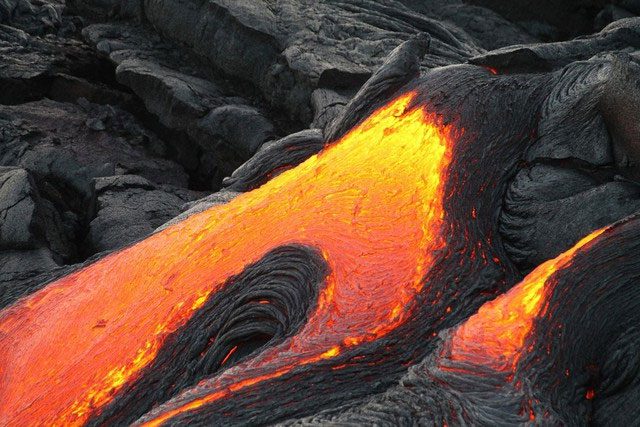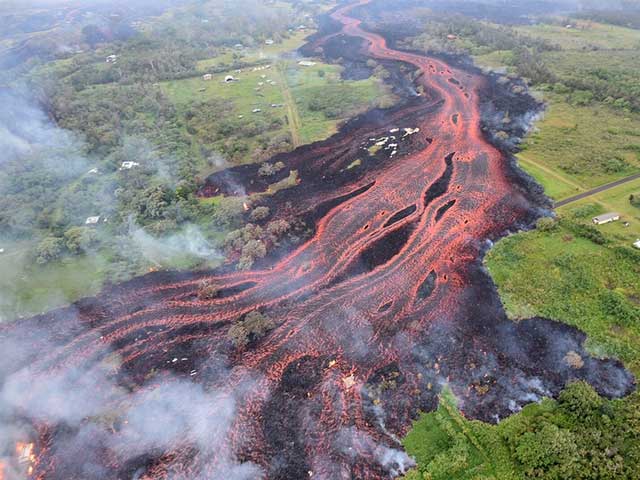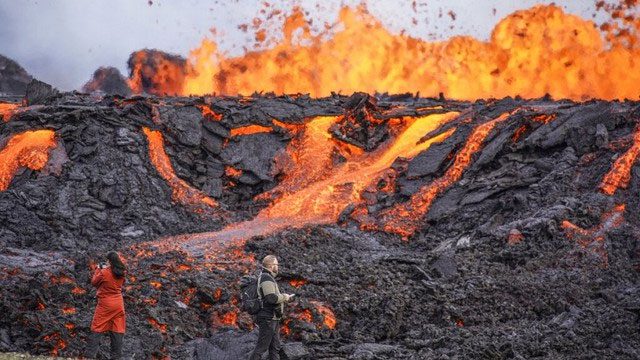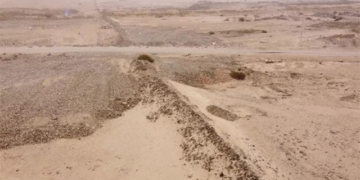In the past, the power of magma has caused countless tragic losses, allowing residents in every corner to feel the strength and majesty of the Earth.
The Destructive Power of Magma: Erosion and Incineration
The corrosive nature of magma is one of its primary aspects of destruction. When magma erupts or spills out, its high temperature and acidity can rapidly erode surrounding materials.
Magma is rich in acidic substances such as sulfuric acid and hydrochloric acid, which can quickly corrode common building materials like metals and stones. During volcanic activity, when magma flows through residential areas, it can cause rapid damage to buildings and infrastructure.
The flammability of magma is also a critical part of its destructive force. The fuel in magma is primarily gases and hydrocarbons, which ignite and release immense energy when exposed to high temperatures. This combustion process is often very intense, generating high-temperature flames and hot gases.

Magma is rich in acidic substances.
During a volcanic eruption, the flammability of magma causes the vegetation surrounding the volcanic vent to be quickly incinerated, potentially leading to wildfires. These fires pose a significant threat to the surrounding ecological environment and the safety of human lives and property.
When magma erupts into the air, its high temperature and energy cause surrounding gases to expand instantly, creating a large amount of magma fragments and volcanic ash. These eruptions can cause severe damage to surface objects and harm nearby animals and humans.
Additionally, magma is highly mobile and can quickly cover and inundate buildings, roads, and land. Historically, some volcanic eruptions have transformed vast areas into deserts, destroying local ecosystems and forcing residents to relocate.

The flammability of magma causes the surrounding vegetation to be quickly burned.
However, despite the destructive power of magma, scientists have implemented various preventative and control measures to mitigate its threat to humans and the environment. For instance, a monitoring system has been established to timely observe volcanic activity and carry out evacuations and early warnings; magma samples are analyzed to gain deeper insights into its composition and properties, thereby predicting the likelihood of future volcanic eruptions. Additionally, materials and technologies resistant to volcanic eruptions are being researched and developed to enhance fire resistance for structures.
Causes of Magma’s Destruction of Vegetation: High Temperature and Chemical Effects
High temperature is one of the primary factors causing magma to destroy vegetation. The temperature of magma can often reach hundreds or even thousands of degrees Celsius, far exceeding the range of temperatures that plants can tolerate. When magma comes into contact with plant surfaces, biological molecules such as proteins, cell walls, and membranes within plant cells are quickly denatured and destroyed, leading to cell death and tissue necrosis. Simultaneously, the high temperature also significantly increases the evaporation and transpiration processes of water, preventing plants from performing photosynthesis and absorbing nutrients normally, ultimately leading to their demise.

Magma contains a large amount of acidic and alkaline substances.
Chemical effects are also a significant reason for magma’s destruction of vegetation. Magma contains a large quantity of acidic and alkaline substances, such as sulfuric acid, hydrofluoric acid, chloride, etc. These chemicals undergo a series of chemical reactions upon contact with plants, causing severe erosion and damage to plant tissues.
For example, sulfuric acid and hydrofluoric acid quickly dissolve plant cell walls and membranes, destroying the structure and function of cells; chloride combines with nutrients in plant cells to form compounds that cannot be absorbed or utilized, further weakening plant vitality.
The eruption of magma also generates massive shock waves and sprays, causing direct mechanical damage to crops. Shock waves can destroy the cellular structure of plants, leading to damage and cell death; sprays can create strong impacts and abrasions on plant surfaces, thus destroying protective layers and outer tissues of the plants.

Shock waves can destroy the cellular structure of plants.
Impact of Magma Disasters on the Environment: Surface Degradation and Soil Pollution
When magma rises and flows out from a volcanic vent, it melts the surrounding geological materials, forming lava. As this lava flows, it melts rocks and cools rapidly, creating a solid magma foundation. This magma bedrock will quickly cover the surface, completely destroying the vegetation and soil above.
Moreover, lava can also flow into bodies of water such as rivers, lakes, and oceans, reducing water surface area and damaging habitats for aquatic species. Additionally, lava can block drainage systems and transportation routes, significantly hindering the socio-economic development of local areas.
Magma disasters can also lead to soil pollution. Lava is rich in metallic elements and toxic chemicals such as iron, sulfur, copper, lead, etc. These substances will dissolve in lava and seep into the soil as it flows.
Once contaminated, soil not only affects the growth and development of crops but also threatens groundwater sources. Soil pollution can lead to vegetation die-off and the death of organisms, destroying ecological balance. Furthermore, if magma disasters occur in densely populated areas, they can also result in casualties and property damage.

Magma melts surrounding geological materials, forming lava.
To cope with the impact of magma disasters on the environment, a series of countermeasures should be implemented to mitigate its effects.
First, it is essential to enhance monitoring systems and early warning mechanisms for magma disasters to timely detect and report potential natural disaster risks, thus preparing preventative and emergency response measures in advance.
Second, after a disaster, it is necessary to quickly assess and restore the environment to eliminate and treat magma residues and pollutants in the soil, while restoring the stability and function of the ecosystem.
Additionally, it is crucial to strengthen scientific research and technological innovation, exploring more effective methods for magma disaster prevention and environmental restoration, while providing a scientific basis to minimize the impacts of magma disasters in the future.




















































